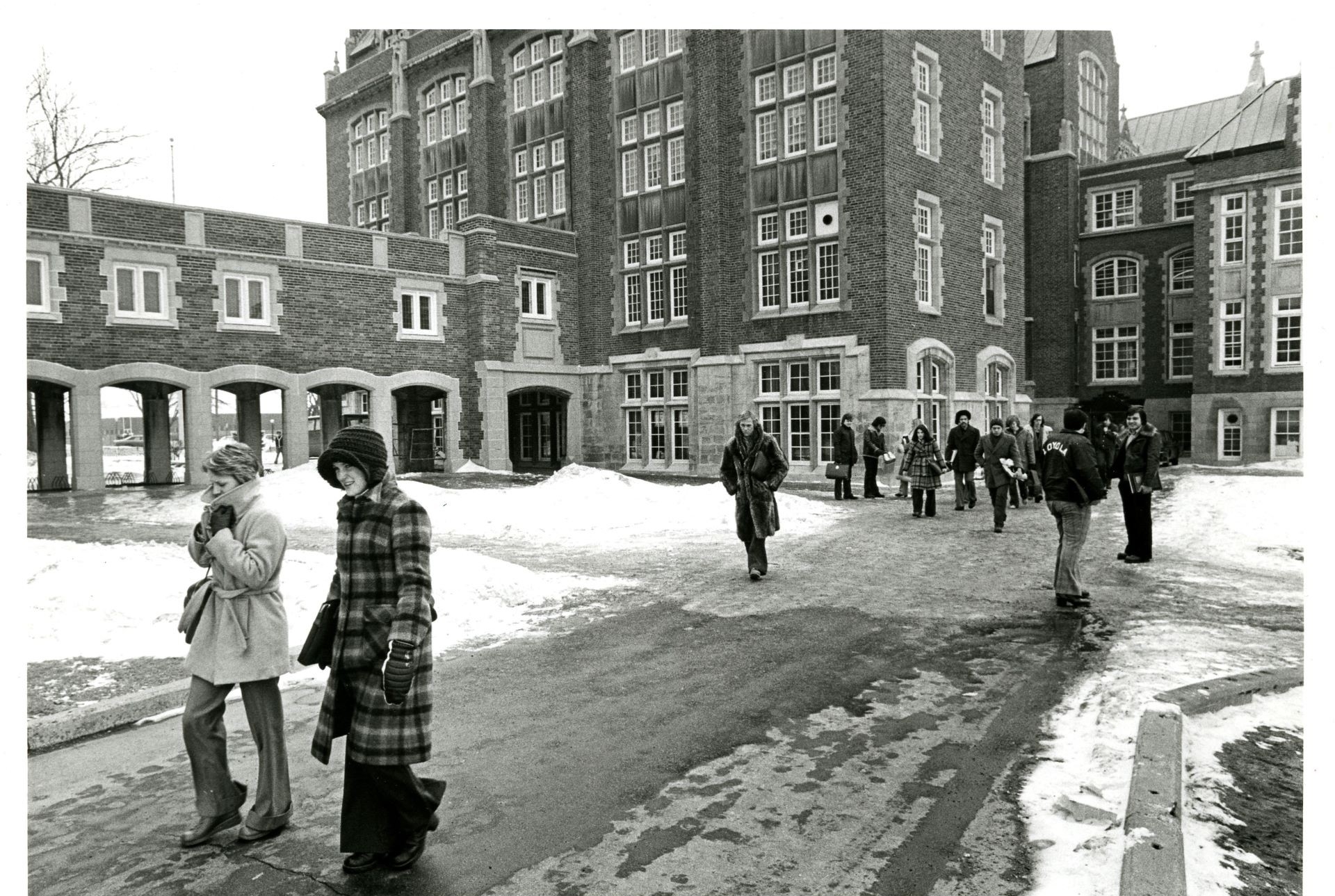50 years: Forever Forward marks Concordia University’s gold and garnet anniversary. From June 2024 to June 2025, our milestone will rally our community of more than 45,000 students, 7,000 staff and faculty as well as 260,000 alumni. We take pride in Concordia’s history and imagine our future as we culminate our university’s historic fundraising effort, the Campaign for Concordia: Next-Gen Now.
Lens on Concordia
Charting 50 years of growth across two evolving campuses
As the Concordia community gears up to celebrate 50 years since the merger of its founding institutions — Sir George Williams University and Loyola College — learn more about the evolution of the university’s two campuses throughout the decades.
Humble beginnings laid the groundwork for the next-generation buildings and innovative spaces that fill Concordia’s downtown Montreal and Notre-Dame-de-Grâce campuses today. Take a journey into our storied past while celebrating the transformation and progress as we lead into the future.
 The Henry F. Hall Building opened on October 14, 1966, with an estimated 5,000 passersby stopping through its atrium to view the new space. | Photo: Michael Drummond
The Henry F. Hall Building opened on October 14, 1966, with an estimated 5,000 passersby stopping through its atrium to view the new space. | Photo: Michael Drummond
 Pictured in 2005, the Hall Building’s atrium featured a café where students could pick up a snack between classes.
Pictured in 2005, the Hall Building’s atrium featured a café where students could pick up a snack between classes.
 Today, the Hall Building houses a number of social-sciences academic departments, engineering teaching and research labs, the Concordia Theatre, as well as student associations and spaces including the Otsenhákta Student Centre, Noula Student Lounge, Hive Café, Reggie’s Pub, and People’s Potato.
Today, the Hall Building houses a number of social-sciences academic departments, engineering teaching and research labs, the Concordia Theatre, as well as student associations and spaces including the Otsenhákta Student Centre, Noula Student Lounge, Hive Café, Reggie’s Pub, and People’s Potato.
 Students brave the winter chill between the Administration Building and the Chapel on Loyola campus in 1974. The Administration Building was only two storeys high until it was finally completed in 1927.
Students brave the winter chill between the Administration Building and the Chapel on Loyola campus in 1974. The Administration Building was only two storeys high until it was finally completed in 1927.
 The relaxed green spaces of Loyola campus now house renovated study and library spaces and offer state-of-the-art facilities like the School of Health, Applied Science Hub, Richard J. Renaud Science Complex, and Oscar Peterson Concert Hall.
The relaxed green spaces of Loyola campus now house renovated study and library spaces and offer state-of-the-art facilities like the School of Health, Applied Science Hub, Richard J. Renaud Science Complex, and Oscar Peterson Concert Hall.
 Before Concordia purchased the Faubourg building — on the corner of Guy and Ste. Catherine streets — in 1997, the space was home to an automobile showroom, pool room, bowling alley, tavern, and then an urban market (pictured), part of what was then known as Le Faubourg.
Before Concordia purchased the Faubourg building — on the corner of Guy and Ste. Catherine streets — in 1997, the space was home to an automobile showroom, pool room, bowling alley, tavern, and then an urban market (pictured), part of what was then known as Le Faubourg.
 Today, the tower — initially intended to be a hotel — sits next to the original building and includes next-gen study spaces, as well as the Mel Hoppenheim School of Cinema, the Centre for Continuing Education, and District 3 Innovation Hub.
Today, the tower — initially intended to be a hotel — sits next to the original building and includes next-gen study spaces, as well as the Mel Hoppenheim School of Cinema, the Centre for Continuing Education, and District 3 Innovation Hub.
 The Sisters of Charity of Montreal, also known as the Grey Nuns, first established its Mother House at the intersection of Guy Street and Dorchester Boulevard (now René-Lévesque) in 1871. At its centre was the Chapel of the Holy Cross, which hosted its first mass in 1878. | Photo: Sœurs de la Charité de Montréal 'Sœurs Grises' – Services des archives et des collections
The Sisters of Charity of Montreal, also known as the Grey Nuns, first established its Mother House at the intersection of Guy Street and Dorchester Boulevard (now René-Lévesque) in 1871. At its centre was the Chapel of the Holy Cross, which hosted its first mass in 1878. | Photo: Sœurs de la Charité de Montréal 'Sœurs Grises' – Services des archives et des collections
 The Mother House, which was acquired by Concordia in 2007, now finds renewed purpose as the Grey Nuns Building. In the chapel’s place today is the Grey Nuns Reading Room (pictured), part of Concordia Library, where students sit at lamp-lit tables rather than pews.
The Mother House, which was acquired by Concordia in 2007, now finds renewed purpose as the Grey Nuns Building. In the chapel’s place today is the Grey Nuns Reading Room (pictured), part of Concordia Library, where students sit at lamp-lit tables rather than pews.
 In the apse, where priests once orated, students can now sit back and study or relax in comfortable reading chairs.
In the apse, where priests once orated, students can now sit back and study or relax in comfortable reading chairs.
 Randy Phillips, BA 74, was a member of the Concordia Stingers men's basketball team from 1972 to 1975. | Photo: Montreal Gazette
Randy Phillips, BA 74, was a member of the Concordia Stingers men's basketball team from 1972 to 1975. | Photo: Montreal Gazette
 Stingers women's basketball player Serena Tchida recreates the image with Montreal’s skyline behind her on Concordia’s downtown Sir George Williams campus. Tchida is an undergraduate student in marketing who was named to the Réseau du Sport Étudiant du Québec's All-Star team this year.
Stingers women's basketball player Serena Tchida recreates the image with Montreal’s skyline behind her on Concordia’s downtown Sir George Williams campus. Tchida is an undergraduate student in marketing who was named to the Réseau du Sport Étudiant du Québec's All-Star team this year.
 Loyola College was built on an apple orchard, donated by Giovanni Donegani in the mid-1800s. Construction of the new campus didn’t begin until 1913, yet the first students moved in just two years later before the buildings were fully completed. The college first offered courses for young men, opening its doors to women only in 1959. | Photo: Richard Arless Associates
Loyola College was built on an apple orchard, donated by Giovanni Donegani in the mid-1800s. Construction of the new campus didn’t begin until 1913, yet the first students moved in just two years later before the buildings were fully completed. The college first offered courses for young men, opening its doors to women only in 1959. | Photo: Richard Arless Associates
 Concordia’s Loyola Campus in Montreal’s Notre-Dame-de-Grâce neighbourhood now blends cutting-edge facilities with turn-of-the-century buildings and residences, and an athletics complex.
Concordia’s Loyola Campus in Montreal’s Notre-Dame-de-Grâce neighbourhood now blends cutting-edge facilities with turn-of-the-century buildings and residences, and an athletics complex.
